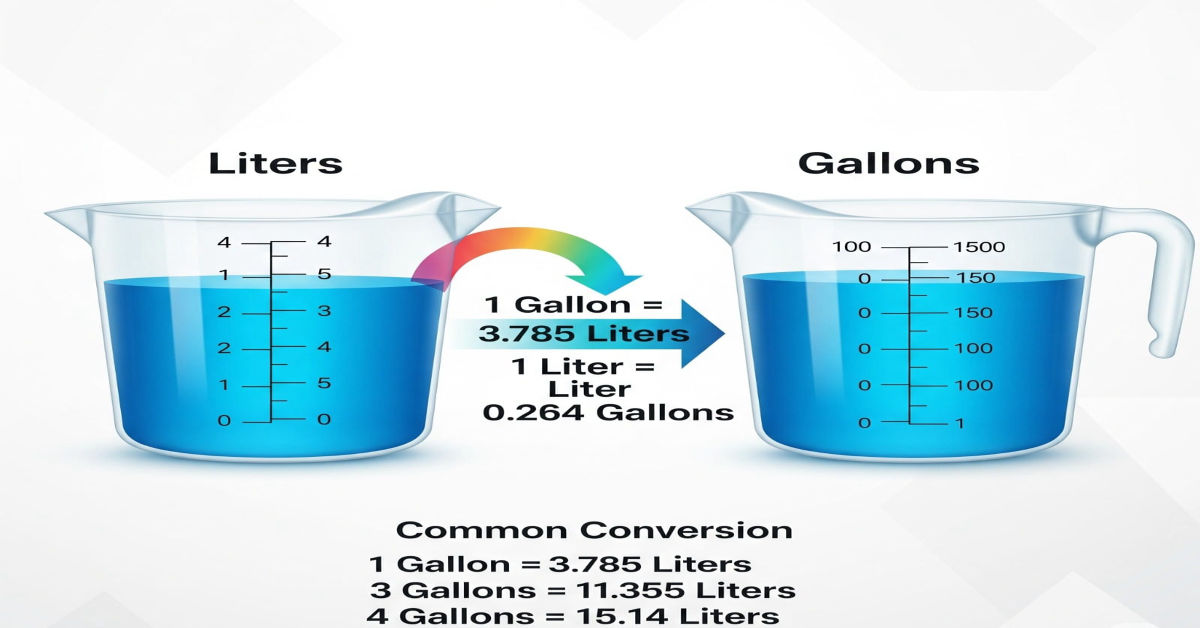When it comes to measuring liquids one of the most common questions people ask is how many liters are in a gallon. This question might sound simple but the answer depends on which type of gallon you are referring to. The world uses different measurement systems, and the United States, the United Kingdom and a few other countries apply distinct standards that can cause confusion. Whether you are cooking, fueling a vehicle, studying science or working in global trade understanding liquid measurement conversions is essential.
This article provides a complete, well-researched guide to explain the relationship between liters and gallons. It explores the different types of gallons, explains why they vary and offers practical tips for converting between the two systems. Along the way you will also find detailed tables, real-world examples and easy methods to make sure you can handle this conversion confidently in your daily life.
What is a Gallon ?
A gallon is a unit of volume primarily used in the United States and a few other regions that have not fully switched to the metric system. Unlike liters, which belong to the metric system and are standardized worldwide, the gallon has different values depending on where it is used. The two main types of gallons are the US gallon and the UK or imperial gallon.
The US gallon is widely used in the United States for fuel, milk, and other liquid products. One US gallon equals 128 US fluid ounces. On the other hand, the UK or imperial gallon, which is still used in parts of the Commonwealth, equals 160 imperial fluid ounces. This difference means that the imperial gallon is larger than the US gallon. Understanding which gallon is being referred to is crucial before making any conversion to liters.
What is a Liter ?
A liter is a standard unit of volume in the metric system. It is internationally recognized and used in nearly every country in the world. One liter is equal to 1000 milliliters or one cubic decimeter. Its simplicity and universal acceptance make it the most convenient measurement for liquids in scientific, culinary, and industrial applications.
Because of the metric system’s decimal-based structure, liters are easy to convert to smaller or larger units, such as milliliters or kiloliters. This is one of the reasons many countries have abandoned the gallon in favor of liters. Understanding how liters fit into the measurement system helps make conversions much easier, especially when comparing them with non-metric units like gallons.
How Many Liters in a Gallon
Now comes the most important question: how many liters are in a gallon. The answer depends on whether you are converting a US gallon or a UK gallon.
- One US gallon equals approximately 3.785 liters.
- One UK or imperial gallon equals approximately 4.546 liters.
This difference may appear small, but in larger quantities, it can create significant variations. For example, if you fill a car’s fuel tank in the United States and compare it with a car in the United Kingdom, the number of liters required for the same gallon measurement will not be the same. This is why global industries, such as aviation and shipping, usually rely on liters or metric tons to avoid confusion.
Gallons to Liters
To make conversions easier, here is a detailed table showing the values of both US and UK gallons in liters.
| Gallons | US Gallons to Liters | UK Gallons to Liters |
| 1 | 3.785 L | 4.546 L |
| 2 | 7.570 L | 9.092 L |
| 5 | 18.925 L | 22.730 L |
| 10 | 37.850 L | 45.460 L |
| 20 | 75.700 L | 90.920 L |
| 50 | 189.250 L | 227.300 L |
| 100 | 378.500 L | 454.600 L |
This conversion chart can be very useful for quick reference whether you are traveling, studying, or working with international measurements.
Why Do Gallons Differ
The variation between the US gallon and the UK gallon originates from historical differences in measurement systems. The US gallon traces back to an English wine gallon used in the early 18th century. In 1824, the British government standardized a new imperial gallon, which was based on the volume of ten pounds of water. Meanwhile, the United States retained the older wine gallon.
Over time, these different standards became permanent, leading to the two distinct definitions of a gallon that we still use today. This historical background explains why confusion often arises when converting gallons to liters, especially in global contexts.
Practical Uses of Gallon to Liter Conversion
Knowing how many liters are in a gallon has real-world applications in many areas of life. Here are a few examples:
- Automotive fuel: In the United States, gasoline is sold in gallons, while in most other countries it is sold in liters. Understanding the conversion helps travelers estimate fuel costs accurately.
- Cooking and recipes: Some cookbooks or traditional recipes use gallons, while modern international recipes rely on liters. Conversions allow precise measurements.
- Science and education: Students often face problems that involve converting between different units, and this conversion is a common one in chemistry or physics.
- Travel and trade: International trade of liquids like oil, milk, or beverages often requires conversion between gallons and liters for clear communication.
Conversion Formula and Simple Tricks
The simplest way to convert gallons to liters is by using a formula.
- For US gallons: Liters = Gallons × 3.785
- For UK gallons: Liters = Gallons × 4.546
For example, if you have 5 US gallons, multiplying 5 by 3.785 gives you 18.925 liters. This formula is reliable and quick to apply in any situation.
Another trick is to remember approximate conversions for everyday use. For instance, 1 gallon is about 3.8 liters in the US and about 4.5 liters in the UK. Having these rough numbers in mind can help with quick mental calculations without needing a calculator.
Common Conversions in Everyday Life
| Everyday Item | US Gallons | Equivalent in Liters |
| Standard milk jug in the US | 1 gallon | 3.785 L |
| Car fuel tank (average size) | 15 gallons | 56.775 L |
| Small water cooler bottle | 5 gallons | 18.925 L |
| Large aquarium | 20 gallons | 75.700 L |
| Backyard pool (small) | 50 gallons | 189.250 L |
This table helps visualize how gallons convert into liters with familiar examples.
Why Liters Are More Common Today
Despite gallons still being used in the United States and a few regions, liters dominate worldwide. This is mainly because the metric system is simpler, universal, and easier for conversions. International organizations, scientific communities, and industries prefer liters to avoid confusion caused by different gallon definitions.
For instance, in aviation, fuel is always measured in liters or kilograms to maintain accuracy in global operations. Similarly, beverage companies selling soft drinks worldwide rely on liters to maintain consistent packaging. The global shift toward liters demonstrates the practicality and reliability of the metric system.
Conversion Challenges and Misunderstandings
One of the main challenges with gallons and liters is the possibility of misunderstanding the type of gallon being used. For example, someone might assume that a gallon always equals 3.785 liters, without realizing that in the UK it equals 4.546 liters. This misunderstanding can create errors in calculations for trade, travel, or academic work.
Another issue arises in countries where people are not familiar with the metric system. Travelers often face confusion when buying fuel abroad or interpreting recipes from other cultures. To avoid mistakes, it is important to confirm which gallon standard is being applied and then use the correct conversion formula.
Extended Conversion Table: Liters to Gallons
For those who often need the reverse calculation, here is a detailed table that converts liters back into both US and UK gallons.
| Liters | Liters to US Gallons | Liters to UK Gallons |
| 1 | 0.264 gal | 0.220 gal |
| 5 | 1.321 gal | 1.100 gal |
| 10 | 2.642 gal | 2.200 gal |
| 20 | 5.283 gal | 4.400 gal |
| 50 | 13.208 gal | 11.000 gal |
| 100 | 26.416 gal | 22.000 gal |
This reference makes it easier for anyone who is accustomed to liters to understand what they represent in gallons.
Conclusion
Understanding how many liters are in a gallon is not just a mathematical detail but a practical necessity in daily life, global travel, trade, and education. One US gallon equals 3.785 liters, while one UK gallon equals 4.546 liters. These values may seem close, but they can cause significant differences in larger volumes.
By learning the history, conversion formulas and practical uses of these measurements, you can confidently handle conversions in any situation. Whether you are filling up a car, cooking from an international recipe, or working in a scientific field knowing the relationship between liters and gallons will make your tasks easier and more accurate.
FAQs
1. Is a US gallon the same as a UK gallon ?
No, a US gallon is smaller than a UK or imperial gallon. A US gallon equals 3.785 liters, while a UK gallon equals 4.546 liters.
2. Why does the UK gallon differ from the US gallon ?
The difference comes from historical definitions. The United States adopted the older English wine gallon, while the United Kingdom later redefined the gallon in 1824 as the imperial gallon.
3. Which is more commonly used, liters or gallons ?
Liters are more commonly used worldwide because they belong to the metric system, which is standard in almost every country. Gallons are mainly used in the United States.
4. How can I quickly convert gallons to liters without a calculator ?
A quick method is to remember that one US gallon is roughly 3.8 liters and one UK gallon is roughly 4.5 liters. This approximation works well for simple estimates.
5. What industries rely most on gallons ?
In the United States, industries such as fuel, agriculture, and beverage production often use gallons. However, global industries like aviation and international shipping prefer liters to avoid confusion.







